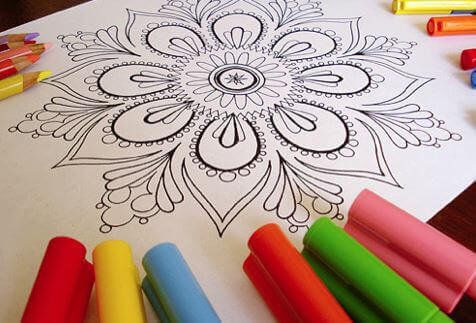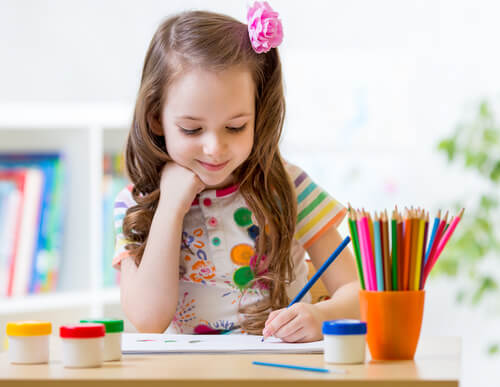6 Benefits of Mandalas for Children that You Didn't Know About

Are you familiar with all the benefits of mandalas for children? We’re told that the origin of the word mandala comes from Sanskrit, and means “perfect circle.”
According to their definition, they are symbolic spiritual forms used in Hinduism and Buddhism. They are constituted or represented by a set of figures and concentric geometric shapes. They’re supposed to symbolize the universe and its characteristics.
Their primary objective is to promote serenity, reflection, and the concentration of energy at one point. Therefore, the benefits of mandalas for children are multiple. Here are some of them.
6 benefits of mandalas for children
1. Generate circular harmony
According to Buddhists, their circular form and drawings help people to order their inner-self. Because of this, it can be very beneficial for children to color in mandalas from a very early age.
Thanks to visual stimulation, this encourages them to create, imagine and find harmony in their emotional disorder.

2. Enhance concentration
Ideally, children should concentrate and be silent when coloring in mandalas. Depending on the complexity of each one, the benefits obtained will vary. The cognitive processes they will use to color in the mandala will increase, and their imagination, attention and flexibility will improve.
The child must finish the mandala in order to achieve the visual and emotional effect it offers them. Children are usually very keen to finish them, so that they can show them off to their family and friends. This stimulates their capacity for responsibility and achievement, and in turn, this will increase their self-esteem.
3. Perfect partners for children with special needs
In addition, for children born with Down’s Syndrome or those who suffer from any type of autism, painting a mandala will be of great help in controlling their movements.
It promotes relaxation and helps them express themselves. In addition, hyperactive children will find this activity to be a fun way to be calm and relaxed.
“We must let them choose the designs that most appeal to them, and encourage them to increase the difficulty progressively”
4. Help develop coordination and psychomotor skills
The use of mandalas can help strengthen a child’s hand-eye coordination. It also helps motor skills in the hands and fingers. This has the effect of gradually enhancing brain connections in children between two and eight years of age.
In addition to these benefits, it helps children improve the accuracy of their writing skills, as well as the skills needed to tie shoelaces or manipulate certain objects.
5. Introduce new words
Painting mandalas is an excellent cognitive stimulator that allows little ones to expand their knowledge and vocabulary. This is due to all the new colors, geometric shapes (circles, squares, triangles, stars, among others), sizes, and even emotions that they’ll be dealing with. In addition to this, they can stimulate a child’s aesthetic sense.

6. Increase their self-esteem
This is one of the most striking benefits of mandalas for children. In coloring in mandalas, a child creates their own original drawing, and develops their cognitive and psychological abilities.
In this way, their self-esteem increases, making them more confident in themselves. They will be able to face difficulties that come their way much more effectively.
“These images have been used throughout history. They encompass mental totality, the conscious and the unconscious, and balancing the inner harmony between the mind and the body”
Remember that to help children make this a regular routine, you need to provide them with the necessary materials for this activity. They will need colored pencils, markers, watercolors, paints, sheets for collages, compasses, rulers, rubbers and everything else that will enable them to paint and color with creativity and imagination.
It’s very important to understand that painting mandalas doesn’t have to become an obligation for children. The important thing is that they enjoy doing it.
You’ll need to find the best moment of the day to suggest that they color. In time you’ll see that they’ll be the ones who will ask you for more and more difficult mandalas to color in. They’ll enjoy the challenge, and you’ll enjoy the peace!
Are you familiar with all the benefits of mandalas for children? We’re told that the origin of the word mandala comes from Sanskrit, and means “perfect circle.”
According to their definition, they are symbolic spiritual forms used in Hinduism and Buddhism. They are constituted or represented by a set of figures and concentric geometric shapes. They’re supposed to symbolize the universe and its characteristics.
Their primary objective is to promote serenity, reflection, and the concentration of energy at one point. Therefore, the benefits of mandalas for children are multiple. Here are some of them.
6 benefits of mandalas for children
1. Generate circular harmony
According to Buddhists, their circular form and drawings help people to order their inner-self. Because of this, it can be very beneficial for children to color in mandalas from a very early age.
Thanks to visual stimulation, this encourages them to create, imagine and find harmony in their emotional disorder.

2. Enhance concentration
Ideally, children should concentrate and be silent when coloring in mandalas. Depending on the complexity of each one, the benefits obtained will vary. The cognitive processes they will use to color in the mandala will increase, and their imagination, attention and flexibility will improve.
The child must finish the mandala in order to achieve the visual and emotional effect it offers them. Children are usually very keen to finish them, so that they can show them off to their family and friends. This stimulates their capacity for responsibility and achievement, and in turn, this will increase their self-esteem.
3. Perfect partners for children with special needs
In addition, for children born with Down’s Syndrome or those who suffer from any type of autism, painting a mandala will be of great help in controlling their movements.
It promotes relaxation and helps them express themselves. In addition, hyperactive children will find this activity to be a fun way to be calm and relaxed.
“We must let them choose the designs that most appeal to them, and encourage them to increase the difficulty progressively”
4. Help develop coordination and psychomotor skills
The use of mandalas can help strengthen a child’s hand-eye coordination. It also helps motor skills in the hands and fingers. This has the effect of gradually enhancing brain connections in children between two and eight years of age.
In addition to these benefits, it helps children improve the accuracy of their writing skills, as well as the skills needed to tie shoelaces or manipulate certain objects.
5. Introduce new words
Painting mandalas is an excellent cognitive stimulator that allows little ones to expand their knowledge and vocabulary. This is due to all the new colors, geometric shapes (circles, squares, triangles, stars, among others), sizes, and even emotions that they’ll be dealing with. In addition to this, they can stimulate a child’s aesthetic sense.

6. Increase their self-esteem
This is one of the most striking benefits of mandalas for children. In coloring in mandalas, a child creates their own original drawing, and develops their cognitive and psychological abilities.
In this way, their self-esteem increases, making them more confident in themselves. They will be able to face difficulties that come their way much more effectively.
“These images have been used throughout history. They encompass mental totality, the conscious and the unconscious, and balancing the inner harmony between the mind and the body”
Remember that to help children make this a regular routine, you need to provide them with the necessary materials for this activity. They will need colored pencils, markers, watercolors, paints, sheets for collages, compasses, rulers, rubbers and everything else that will enable them to paint and color with creativity and imagination.
It’s very important to understand that painting mandalas doesn’t have to become an obligation for children. The important thing is that they enjoy doing it.
You’ll need to find the best moment of the day to suggest that they color. In time you’ll see that they’ll be the ones who will ask you for more and more difficult mandalas to color in. They’ll enjoy the challenge, and you’ll enjoy the peace!
All cited sources were thoroughly reviewed by our team to ensure their quality, reliability, currency, and validity. The bibliography of this article was considered reliable and of academic or scientific accuracy.
- Calvachi Castellanos, M. E. (2012). Los mandalas infantiles como técnica educativa para el desarrollo de la creatividad en los niños y niñas del Jardín de Infantes Casa de la Cultura Ecuatoriana de Quito en el año 2011. http://www.dspace.uce.edu.ec/handle/25000/310
- Díaz Ballesteros, N. M., Sandoval Guzmán, J. C., & Rodríguez Preciado, C. A. (2015). Los mándalas como herramienta para fortalecer la atención en la asignatura de matemáticas en los niños de primero a del colegio Venecia sede b jornada tarde en Bogotá. http://repository.libertadores.edu.co/handle/11371/172
- CAZA CHANGO, E. P. (2015). MANDALAS EN EL PROCESO DE ENSEÑANZA-APRENDIZAJE. GUÍA DIDÁCTICA PARA LA CORRECTA UTILIZACIÓN DE LOS MANDALAS EN EL PROCESO DE ENSEÑANZA-APRENDIZAJE DE LOS NIÑOS Y NIÑAS DE 5 AÑOS DE EDAD DEL JARDÍN DE INFANTES Y ESCUELA PARTICULAR” EUSTAQUIO MONTEMURRO” DEL DMQ DURANTE EL AÑO LECTIVO 2014-2015 (Bachelor’s thesis). http://www.dspace.cordillera.edu.ec:8080/xmlui/handle/123456789/187
This text is provided for informational purposes only and does not replace consultation with a professional. If in doubt, consult your specialist.








